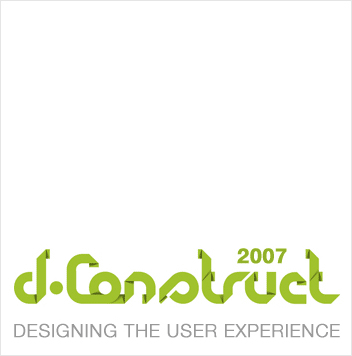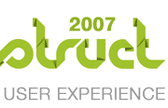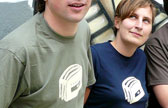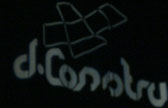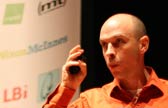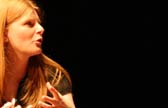Last week I had the pleasure of visiting Brighton to attend the 2007 dConstruct conference. This is a small grass roots conference by Clearleft which is billed as ‘an affordable, one-day conference aimed at those designing and building the latest generation of web-based applications’. The topic for this third annual conference was Designing the User Experience.
Jared Spool opened the conference with his enthusiastic, engaging and entertaining presentation entitled “The Dawning of the Age of Experience”. Jared talked about the iPod (as did almost every presentation). The iPod isn’t the best MP3 player technologically speaking, but because the user experience is so rich the device is by far the highest selling product in the market. The iPod doesn’t have all the features other MP3 players have, but functionality commonly found on other devices has been cleverly moved to iTunes. More often than not you manage your music on a computer and Apple has recognised this behaviour. They have moved such functionality to iTunes leaving the iPod less cluttered and easier to use – all which lead to great user experience. This great user experience is something you should be building in to every service you provide.
Jared also compared Netflix, a relatively new online-only movie rental company, to Blockbuster, the well established DVD rental company, with over five-thousand stores in the US alone. Over recent years Netflix has become twice as large as Blockbuster. But they don’t advertise and they don’t have retail stores, so why have they become so successful? They found out 85% of existing customers had a friend recommend the service to them. Because they spend their money of designing their website and improving user experience, they do not need conventional marketing to become extremely successful. User experience makes and breaks products and services.
Jared was followed by another American, Peter Merholz, who works for Adaptive Path and talked on the subject of “Experience Strategies”. Peter started with a history lesson about camera development in the late eighteen-hundreds.
Up to the turn of the nineteenth century, photography wasn’t very accessible, requiring complex understanding of fundamentals and needing seventeen steps to complete the process. Kodak developed a “3 step camera” and their slogan was “You press the button, we do the rest”. Kodak didn’t change how photographs were developed, they simply recognised that the user should not need to know this information to take photographs. All the user had to do was push the button and send the film off, Kodak then did the rest. And because of this user experience Kodak have been the premier brand in the photography industry for over one hundred years.
Secondly Peter talked about a pyramid of product evolution:
- At the bottom is the underlying product technology.
- Second are features. Features make technology more usable. Beware, simply cramming in features can ruin a product.
- Finally, experience is the most important part of the pyramid. Focus on what people want to do, and hide the rest — see the iPod!
All these steps are required and each is important, but the user experience can either ruin or make the product a great success.
The first two presentations complemented each other perfectly. Peter referenced and expanded upon information which Jared had just talked about and the two speaker styles fitted together very well. Both speakers were engaging, knowledgeable and able to communicate their experience extremely well.
After lunch Jeremy Keith, one of the event organisers, introduced Cameron Moll for the so-called “graveyard-watch”, in which he presented “Good vs. Great Design”. Cameron talked about choices which distinguish great design from good design and stated that this contributes to user experience because “great design yields meaningful communication”. Cameron posed the following question, which I felt was intriguing…
Using a microwave, which takes less time?
- Heating water for one minute and ten seconds?
- Heating it for one minute and eleven seconds?
A trick question? Partially. Below this question Cameron stated “User productivity trumps machine productivity”. Although it maybe quicker for the machine (microwave), the overall process for the user is slower. In choice one the user has to locate two buttons, 1 and zero, which are usually positioned away from each other. The second choice requires one button, and therefore is quicker for the user. This is very important to remember when developing any software applications, you should think about user efficiency over the ease of programming.
Finally, the conference finished with Tom Coates, a former employee at the BBC who is currently heading up a very interesting research project called FireEagle at Brickhouse Yahoo!. Tom talked on the most technical-orientated subject of the day in his presentation “Designing for a Web of Data”.
I am very interested in the ‘web of data’ idea – all of the possibilities and phenomenal potential it contains. I believe this topic will be a huge part of the internet in the next few years. If you are intrigued I highly recommend viewing Tom’s other presentation on the subject “Native to a Web of Data”. You can view the slides and listen to the audio from the presentation which I watched at The Future of Web Apps in early 2006.
Other presentations
Leisa Reichelt presented “Waterfall Bad, Washing Machine Good” in which she talked about project development methodologies, discussing the differences between sequential methodologies and ‘iterative, incremental and collaborative/cross-disciplinary methodologies’. The talk was more project-management orientated, but enlighten the benefits of Agile and User Centred Design (UCD) practices.
George Oates and Denise Wilton had an informal chat on the sofa entitled “Human Traffic”. These two talked about the processes their respective companies go through when making design and interface choices and how they are handled in the fast response/feedback nature of the internet. Personally, this was my least favourite talk of the conference.
“The Experience Stack” presented by Matt Webb was an interesting talk. Matt threw away common presentation structure and gave a sporadic and sprawling talk about ‘experience’. I felt some of the slides were confusing and because of the unrelated nature of the presentation, understanding the overall premise was difficult. Matt has understood there was a problem with his talk but has tried to address this in an article called The Experience Stack revisited. Matt has put his slides online with extensive notes.
Overall I really enjoyed the conference and thought it was a great success. Andy Budd, one of the organisers, summed up the conference and mentioned what I felt about conferences in general:
The best conferences I find are always the ones that try to inspire rather than educate. … [we] walked into the office this morning with a renewed interest in our field and a desire to try out some new techniques and ideas. I hope you felt the same way.
I did.
